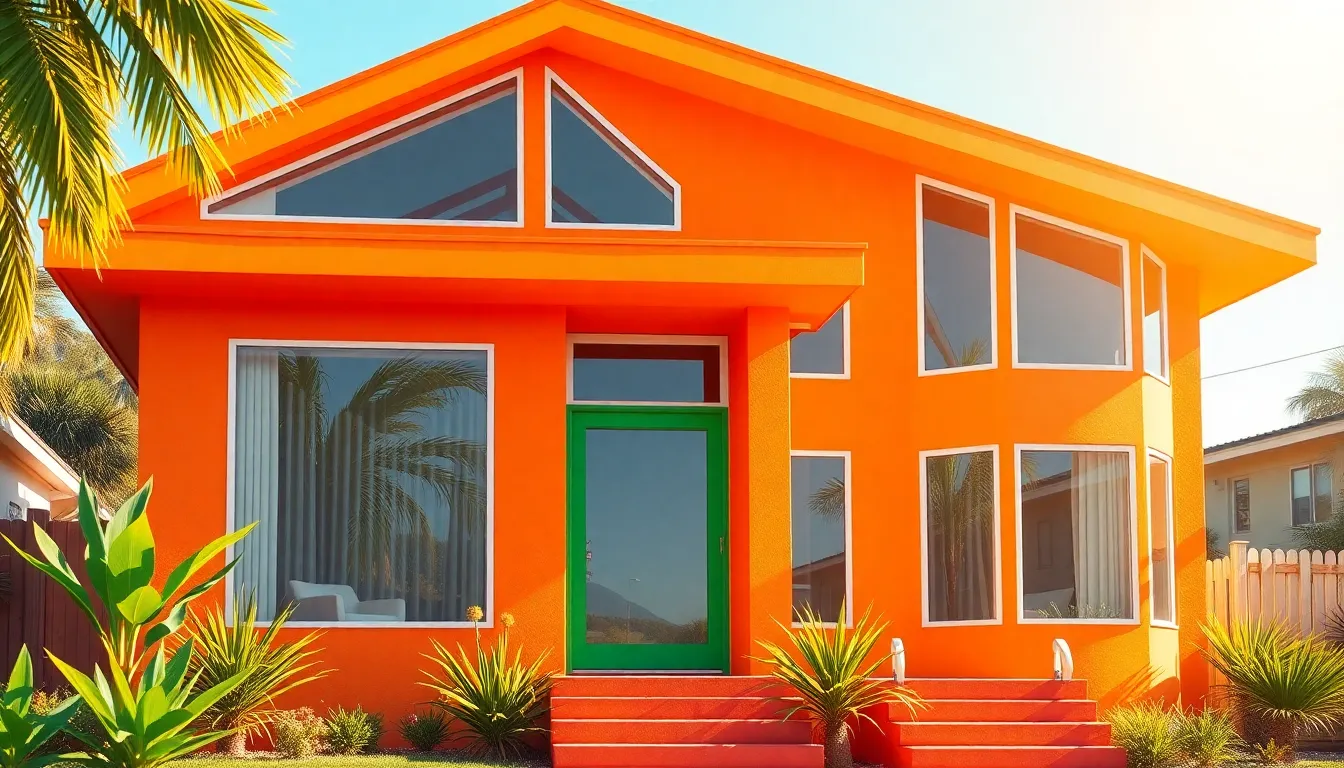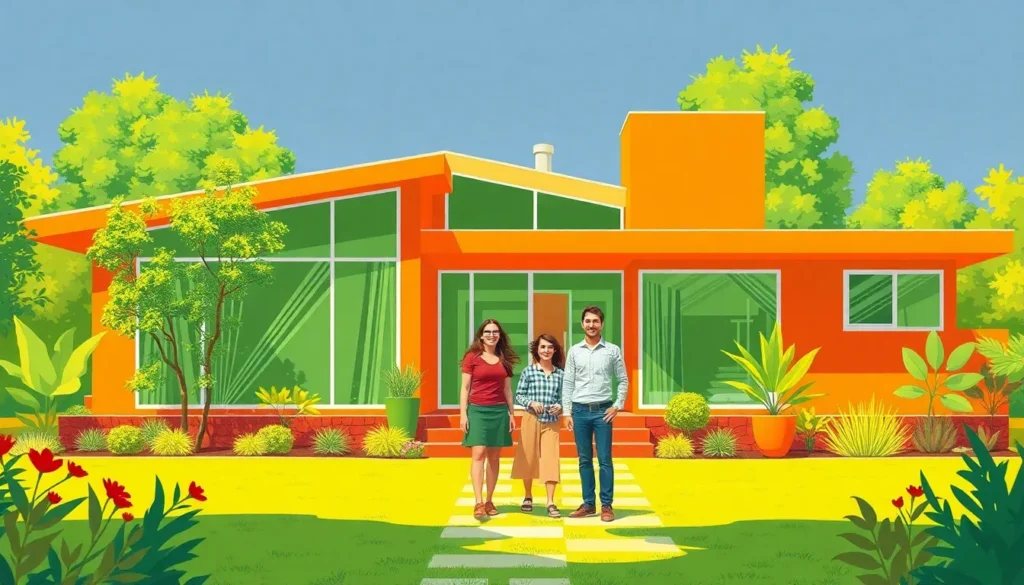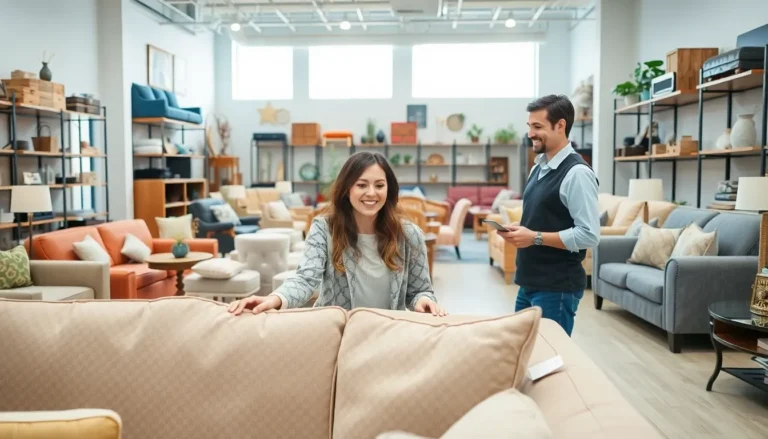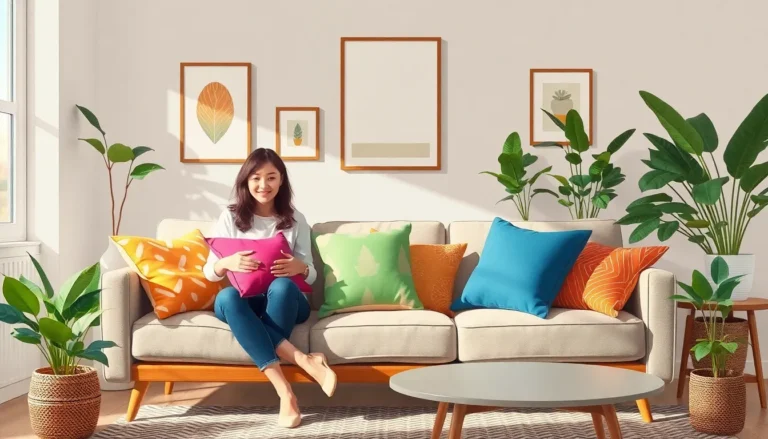Table of Contents
ToggleStep into a time machine and travel back to the days when homes had character, charm, and a touch of whimsy. Retro home architecture isn’t just about nostalgia; it’s a celebration of bold colors, unique shapes, and designs that dared to be different. From the eye-catching curves of mid-century modern to the funky flair of the 70s, these homes tell stories that contemporary structures just can’t match.
Imagine hosting a dinner party in a kitchen with vibrant tile backsplashes and a sunken living room that practically begs for a dance-off. Retro architecture invites creativity and fun, proving that home isn’t just where the heart is; it’s where the style is too. So let’s dive into the captivating world of retro homes and discover why they’re making a comeback, one quirky design at a time. Who wouldn’t want to live in a place that feels like a blast from the past?
Overview of Retro Home Architecture
Retro home architecture embodies a blend of styles, colors, and materials reflecting the cultural moods of past decades. Mid-century modern designs, characterized by clean lines and open spaces, remain influential. The vibrancy of colors often used in these homes, including turquoise, mustard yellow, and avocado green, captures attention and promotes a playful ambiance.
Design elements such as large windows and geometric shapes enhance the appeal of retro architecture. Architectural movement variations, like the 1960s California ranch style, emphasize spacious interiors and outdoor living. Unique roofing styles, including flat and butterfly roofs, showcase innovative craftsmanship.
Homeowners appreciate the quirky details found in retro homes, from funky light fixtures to patterned wallpaper. Many retro houses feature integrated landscaping, which blends indoor and outdoor environments seamlessly. Original materials like cinder blocks and plywood evoke a sense of authenticity and craftsmanship.
The resurgence of retro home architecture aligns with current design trends that favor individuality and sustainability. This architectural style encourages renovations that reflect historical character while integrating modern functionality. Buyers seeking a distinct residence often find these creative designs appealing.
Properties designed in the retro style not only attract attention but also invite nostalgia, making them a unique addition to any neighborhood. Overall, retro home architecture celebrates a distinct era, encouraging appreciation for creative expressions in residential design.
Key Characteristics of Retro Home Architecture

Retro home architecture features vivid colors, unique shapes, and playful designs that bring nostalgia to the forefront. This architectural style combines multiple eras, particularly mid-century modern and 70s aesthetics, creating homes full of character.
Color Palettes
Bold color choices define retro homes. Bright oranges, greens, and funky yellows work together to create striking combinations. These colors play a vital role in establishing the cheerful atmosphere typical of the era. Accent walls often showcase vibrant hues that enhance living spaces. Homeowners appreciate how these palettes evoke creativity and warmth, making retro homes feel inviting.
Design Elements
Distinctive design elements capture attention in retro architecture. Large windows maximize natural light, fostering an open and airy environment. Geometric shapes play a crucial role in defining the overall aesthetic, promoting a modern yet playful vibe. Additionally, unique roofing styles, such as flat or asymmetrical designs, create visual interest and contribute to the home’s personality. Integrating quirky details, like playful light fixtures and patterned wallpapers, further enhances the charm of these residences, making each one a true reflection of individuality.
Popular Retro Home Styles
Retro home architecture encompasses various distinctive styles, each reflecting a unique historical influence. Popular designs often captivate homeowners seeking individuality in their spaces.
Mid-Century Modern
Mid-century modern homes showcase clean lines and functional layouts. Originating in the 1940s to 1960s, these designs embrace simplicity, emphasizing open-concept living. Large windows flood interiors with natural light, seamlessly connecting indoor and outdoor spaces. Iconic features include flat planes and vaulted ceilings, creating a sense of spaciousness. Colorful accents in décor, like vibrant furniture and art, further enhance the mid-century modern aesthetic. This style’s focus on form and function remains attractive, inspiring architects and designers even today.
Ranch-Style Homes
Ranch-style homes, popularized in the 1920s through the 1970s, exemplify single-story living with an inviting open floor plan. The long, low design often features large windows and attached garages, promoting a casual lifestyle. Characteristic elements such as expansive porches and backyards encourage outdoor gatherings and family activities. Traditional use of brick or wood siding complements various landscapes. Variations include the California ranch, known for its integration with the natural surroundings, showcasing how this style adapts to different climates. Homeowners appreciate the blend of convenience and relaxed elegance these homes offer.
Influence of Retro Home Architecture on Modern Design
Retro home architecture significantly shapes modern design. Creativity from past decades inspires contemporary homeowners and architects alike. Vibrant color palettes, such as those found in mid-century designs, influence current trends that utilize bold hues. Unique roof shapes and large windows from retro styles enhance the airy feel in today’s constructions.
Design elements seen in retro architecture continue to appear, promoting openness and connection between spaces. Quirky features, like retro light fixtures and patterned wallpaper, attract those looking to add character and charm. Sustainability also plays a crucial role. Incorporating energy-efficient materials and innovative designs aligns with the eco-friendly focus of many modern builders.
Geometric patterns from the 1950s and 60s often emerge in current interior design. Furniture selections drawing on retro styles feature clean lines and functional layouts, making modern living both stylish and practical. Outdoor spaces receive attention too, with integrated landscaping that echoes the outdoor connections emphasized in ranch-style homes.
Homeowners value individuality today, embracing retro elements that showcase personality. The resurgence of these features highlights a demand for authenticity, which contemporary designs fulfill by blending old with new. As nostalgia fuels desire for unique aesthetics, retro home architecture remains a significant influence in shaping the future of residential design.
Tips for Incorporating Retro Styles in New Builds
Embrace bold colors that define retro aesthetics. Bright oranges, greens, and funky yellows create a cheerful ambiance reminiscent of mid-century modern designs.
Select geometric shapes for architectural features. Large windows and distinct roofing styles enhance natural light and promote openness, creating a welcoming atmosphere within the home.
Incorporate quirky details that add personality. Funky light fixtures and patterned wallpaper serve as conversation starters, enriching the overall character of the space.
Utilize sustainable materials when designing new builds. Eco-friendly practices resonate with the retro ethos of individuality while appealing to environmentally conscious homeowners.
Integrate landscaping with natural elements. Connecting indoor and outdoor spaces fosters harmony and maintains the retro theme, encouraging outdoor gatherings that recall simpler times.
Opt for open floor plans that reflect ranch-style living. This layout supports modern lifestyles while paying homage to the design principles of past decades.
Use furniture pieces with clean lines and functional layouts. Retro-inspired furniture not only complements the architecture but also enhances comfort and usability in everyday living.
Assess local vintage markets for materials and decor. Vintage finds offer authenticity and charm, allowing homeowners to blend retro elements with contemporary design effectively.
Prioritize uniqueness in design choices. Personal touches, such as custom art pieces or heirloom decorations, reinforce the individuality that retro styles champion in modern spaces.
Retro home architecture stands as a testament to creativity and individuality in design. Its vibrant colors and unique shapes not only evoke nostalgia but also inspire modern homeowners to embrace a whimsical lifestyle. As the demand for authenticity grows, these homes offer a refreshing contrast to contemporary trends.
Incorporating retro elements into today’s spaces allows for a joyful living environment that celebrates personal style. By blending sustainability with these playful designs, homeowners can create a harmonious balance between the past and the present. Retro architecture isn’t just a trend; it’s a celebration of character and charm that continues to resonate in the world of residential design.







